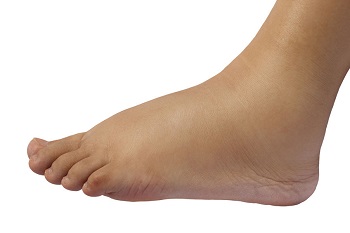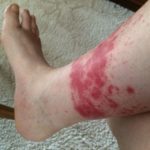Do I need to manage my Swollen Feet?
Foot pain or loss of mobility can alert us to swollen feet, ankles and legs. It may be that there is a circulation problem or there may be an issue of inflammation or infection or even more serious underlying health issues. It is important to be vigilant for signs beyond the swelling, like changes in skin color and shortness of breath. Once you have checked for an underlying health issue it is important to use preventative measures to manage the swollen feet, ankles and legs. Modifications such as exercise, diet, leg elevation and compression may become part of your management routine.
Early foot problems associated with Swelling
#1. Shoes won’t fit
Our feet are squeezed and scrunched into our shoes. This can cause corns, toe deformities and blisters. We take off our shoes, walk barefooted, stand on dangerous objects or bump into furniture. This can cause cuts, lacerations or wounds. We wear flip flops or over-sized shoes that provide no protection or support.
#2. Toenails penetrate swollen toes
Toenails can penetrate swollen toes in 2 ways. As an ingrown toenail- where the fleshy part of the toe engulfs a nail or as a nail cut of the skin of an adjacent swollen toe. In either case a serious wound can develop – undetected. The risk of infection is high
#3. Loss of mobility
Although walking is recommended for swollen feet and legs, pain in the ball of the foot can make walking a complete misery. Even walking short distance from one room to another at home can be excruciating. Ankle range of motion can also be severely affected if the swelling of foot, ankle and leg is considerable. This will cause a plodding style of gait. Walking any distance becomes very difficult
Other signs associated with Swollen Feet
Legs and feet can become swollen for a variety of reasons. Most times the swelling is temporary and easily explained, like sitting on a plane too long. On other occasions the swelling just seems to happen. This may be indication of a more serious medical problem. There may be other things you have been ignoring. For this reason it is wise to check with your doctor.
Watch list if you have Swollen Feet
- When you press on the skin it leaves a hollow
- The skin appears very shiny and stretched
- Appearance of an irregular pink-purple-red rash on the lower leg

- The skin on the legs blister or develop wounds
- The foot and leg pain is continuous day and night
- Chest pain, pressure or tightness
- Shortness of Breath
- Swelling in one leg only
How to Manage Swollen legs feet and legs
- See your doctor to clarify the cause of the swelling
- Work your leg muscles. Walking or Treadmill walking is great if you can. If walking is too painful, try an indoor bike. Walking and moving in a swimming pool can be incredibly soothing with limited weight on your feet. Another option is sitting on a chair doing leg raises and ankle flexion/extension
- Elevate your legs and feet. Some people lie on the floor with their feet on the couch, others develop their yoga and can do shoulder stands. Do what you can.
- Massage is helpful for some people. Check with your doctor first.
- Reduce salt in your food and drinks. It may help
- Upgrade your shoes. Invest in some new cushioned, adjustable shoes. Laces or Velcro straps can be loosened as the swelling increases during the day. Allow plenty of room for your toes too.
- Wear compression stockings. You can buy these from a pharmacy, but I always recommend that you be measured and fitted by a physiotherapist. One word of warning: Compression stockings may squeeze your feet too much and take up too much room in your shoes,
- Monitor your Skin. Keep an eye on the colour, temperature or texture of your skin. Are there nails cutting into adjacent toes? Has the skin underneath your feet become dry and cracked? See your Podiatrist
The feeling of tight shoes may be caused by swollen feet. This may be the first indication of a serious underlying medical condition. It is important to check with your doctor and watch out for other changes in your feet and legs. Good habits to help manage swollen feet and legs just make sense!
Updated June 2021





